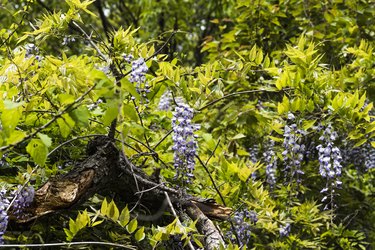
Wisteria root removal is a difficult process that isn't always successful. Because American wisteria (Wisteria frutescens, USDA plant hardiness zones 5 to 9) is a type of vining plant, it climbs up mature trees and often constricts them as the wisteria reaches for the sun. If a non-native species has overtaken nearby trees, try to remove it by cutting or with herbicide.
Invasive and Native Wisteria
Video of the Day
American wisteria blooms in June and July. If you notice wisteria blooming around April or May, it's most likely a non-native species, such as Japanese wisteria (Wisteria floribunda, zones 4 to 9) or Chinese wisteria (Wisteria sinensis, zones 5 to 8). Wisteria can also be identified by its pods. Japanese and Chinese wisteria pods have a thick layer of velvety, short hairs, while American wisteria pods are smooth and hairless.
Video of the Day
Wisteria also differs in how it blooms. American wisteria blooms from the base and then down the flower stem, while Japanese and Chinese wisteria flower stems bloom all at once. Wisteria can also be identified based on how it twines. Unlike Chinese and American wisteria, which twine counterclockwise, Japanese wisteria twines clockwise.
Wisteria Roots Removal
Before you start removing wisteria roots, cut the stems to gain easier access. Cutting the stems into manageable lengths permits easier disposal. You may find seeds or pods on the ground as you cut the stems, so be sure to collect them using a rake and dispose of them to avoid more wisteria growing in your yard.
Wisteria also spreads by suckers, which are small offshoots that grow from underground root systems. Be sure to pull these from the ground as well.
Bag the seeds, pods and suckers and dispose of them at a reliable composting site. If a composting site is unavailable, add the wisteria remnants to a landfill.
Wisteria Roots Removal by Cutting
While complete removal of the stems and leaves should theoretically kill the plant, suckers will continue to emerge from the ground unless the roots are completely removed as well.
Dig around the remaining stem. Cut and remove parts of the stem and pull up the roots with it. Continue to do so until you have removed the entire root system.
It's challenging to remove non-native species. You won't know for sure if your wisteria root removal was a total success for some time. Keep an eye out for suckers and remove them and the roots below them if more appear.
Wisteria Removal Using Herbicide
If you are not opposed to using an herbicide, utilize a cut and treat method for vines that are 1/2 inch or more in diameter. First, cut the wisteria vine with hand pruners or a saw at the base of the tree. Then, let it hang. The vine will eventually wither and die.
Follow the vine to the ground and cut at the base. Then, treat it with herbicide. Be careful to only treat the cut and nothing else. Use a high-concentrate glyphosate-based solution between 18 and 50 percent.
Be sure to treat the cut within 10 minutes of the incision or the cut will dry out and be unable to absorb the herbicide.